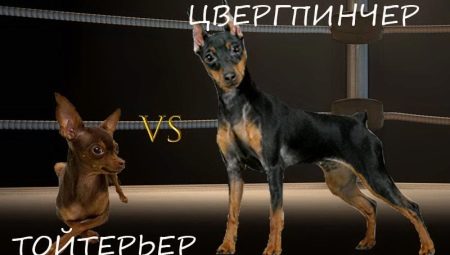Today it is very popular to purchase small dogs. They attract many fashionistas and socialite ladies who prefer to stroll regularly with their four-legged friends, dressing them in beautiful fur coats. The small size of the dogs is very popular, because such animals can be taken with you on trips or trips without any problems, and they do not require too scrupulous care. In this article, we will examine how pinschers differ from toy terriers, find out what kind of care they need, and also get acquainted with the conditions of their detention.

Description of toy terriers
Russian toy terriers are very small dogs, are decorative, their growth is from 20 to 28 cm at the withers. They weigh about 2.5-3 kg. To date, toy terriers are short-haired and long-haired.
Dogs belonging to this breed have many advantages: they are very affectionate, kind, obedient and loyal to their owners. Despite the fact that the animals are quite small, they are very hardy and prudent. The breed standards include the following characteristics.
- A rounded and not wide head, while the forehead is convex.
- Flat back of the nose and tightly pressed lips. The outer line of the lips, as a rule, is painted in dark color. The nose is dark, but sometimes the shade depends on the color of the coat. The bite is correct, the teeth are small but even.
- Slightly bulging eyes.
- Ears are triangular, standing upright. They do not stop.
- The muzzle, like all limbs, is dry. The hind limbs are slightly wider than the front.
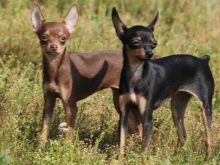
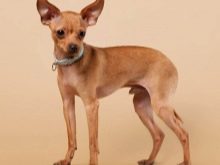
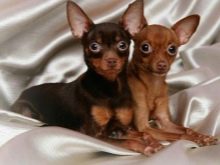
According to breed standards, the toy terrier’s tail usually stops up to 2-3 vertebrae, but sometimes they leave it.
Having considered the advantages of toy terriers, we will consider their disadvantages.
- A difficult upbringing, especially if the dog was not taken as a puppy.
- Hypersensitivity to temperature changes. These miniature dogs are very afraid of the cold.
- The presence of genetic diseases. These dogs are very prone to knee dislocation. They may also have problems changing teeth.
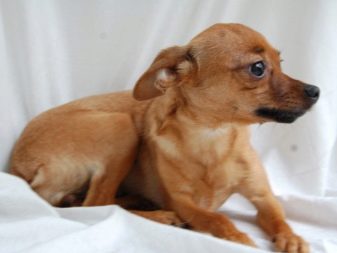
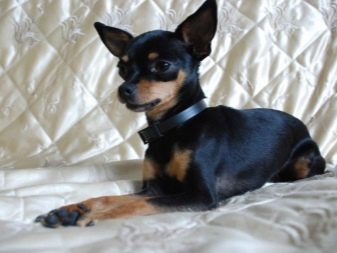
Pinscher Description
Dwarf pinschers are slightly larger than Russian toy terriers. Their height reaches 30 cm, and their weight is from 3 to 5 kg. Such dogs have a very harmonious and sinewy body. They are very similar to a small copy of the Doberman. Also to the characteristics of the pinschers include the following.
- A triangular head with a flat forehead. The transition to the nose is smooth.
- The eyes are convex and oval. The nose is almost always saturated black.
- The ears when stopping, they remain upright or semi-permanent if not cut off.
- Chest quite wide, while oval.
- This breed has a very strong neck and all limbs are parallel to each other, while the hind limbs are slightly pulled back.

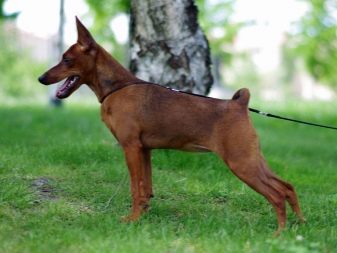
Pinscher tails are often docked. Pinschers are very active dogs, they are energetic and always friendly with the owners.. These animals are very athletic in body shape, and savvy in nature. But they are also quite willful and stubborn, and therefore need relatively strict education. They are difficult friends with children, they can put themselves above them.
But at the same time, such shortcomings can always be eliminated by training and other regular training.
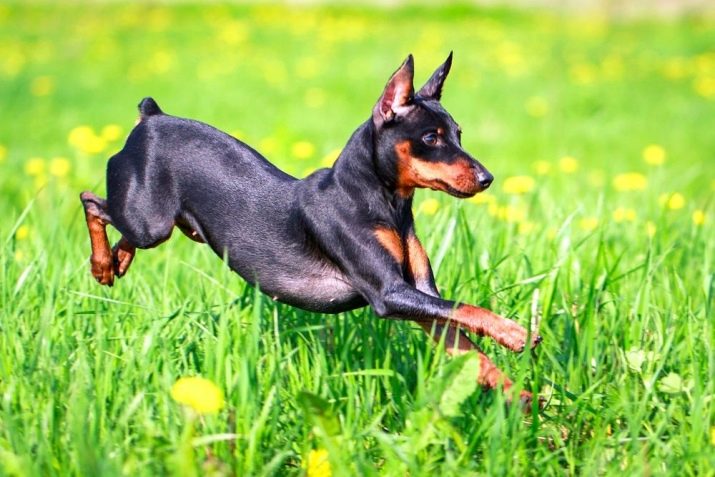
Distinctive and similar features
Both toy terriers and pinschers, also called miniature pinschers, get along equally well with other animals. They are very friendly at any age, especially puppy-friendly.
Consider the differences.
- Toy terriers and dwarf pinschers have a similar appearance, and therefore many lovers often confuse them. But at the same time, the former have a more fragile, modest and neat appearance, like a deer, and the latter have a stronger and more muscular appearance. Distinguishing them is not difficult, knowing these traits.
- Both breeds differ in character. In order for the Pinchers to behave themselves compulsively, they need to run and play regularly, otherwise they are lazy. Toy terriers are not so active and they do not need constant movement, although they love walking.
- Both breeds, despite their very miniature size, are always ready to protect their loved ones and owners. But in general, they are not hostile if they are not very angry.
- As for education, then toy terriers are usually trained to be educatedFor example, they did not bark for no reason and at the same time knew the main teams. But dwarf pinschers should be trained for a long time, otherwise they may begin to feel superior to their own owners.
- Toy Terriers have soft hair. compared to the hard pinscher skin.
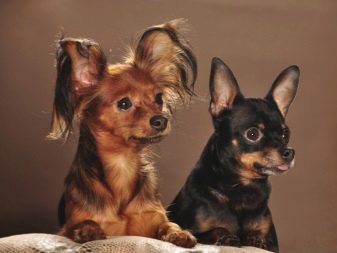
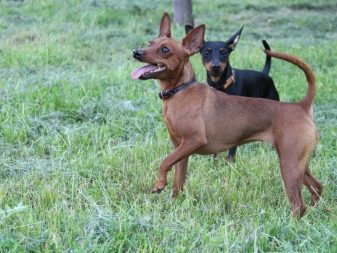
Similar features.
- Both breeds are almost identical in height and weight. The maximum weight of toy terriers is only 3 kg, dwarf pinchers can weigh from 3 to 5 kg. The difference in growth is also only a few cm, which is not a significant difference.
- Both breeds are similar in color. By standards, pinschers can be red, hazel or deep brown, and often black. Toy terriers can also be black, red and chocolate.
- Dogs are also similar in ears. Cropped ears of pinschers are very reminiscent of the ears of toy terriers. Tails according to the standards of both breeds stop if desired.
- Both breeds also have a lot in common. in character and temperament, they are very loyal to their masters and study well if they are regularly trained. Although dogs are from different breeds, they equally need attention.
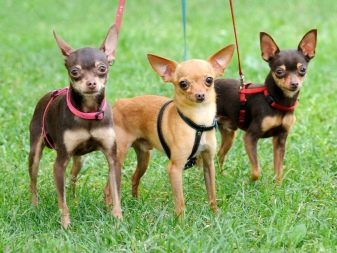
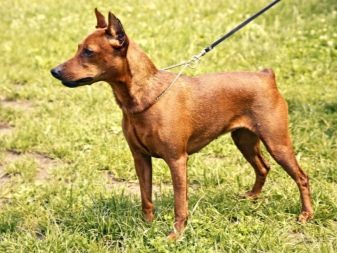
On average, dogs from both breeds live 13-15 years. Duration and quality of life always increase if animals are sterilized or neutered.
Dog prices vary. So, pinschers and toy terriers on average cost from 25 to 35 thousand rubles, if we talk about thoroughbred individuals from elite nurseries. Individuals over several thousand are extremely difficult to find, as a rule, they do not have a pedigree.
Dwarf pinschers very often participate in exhibitions and competitions, but toy terriers are often only in exhibitions, this is due to some features of their health.
Girls puppies from both breeds are usually very calm, but boys can be harmful. They can mark all the corners in the house if they are not taken on time to castration.
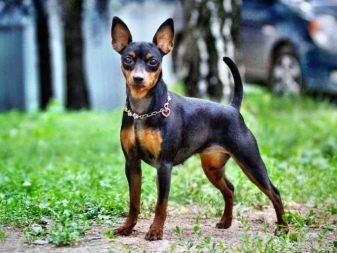
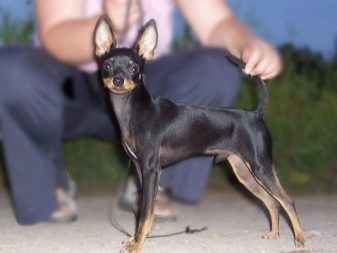
Care and maintenance
Both breeds are easily accustomed to the toilet (diaper), which is important, because it is not always possible to walk the dog. Caring for animals is not difficult, but it should be regular, including:
- nail clipping (usually every 2-3 weeks);
- ear cleaning;
- bathing several times a year, as well as washing paws after each walk on the street;
- annual vaccinations;
- cleaning wool with a special brush.
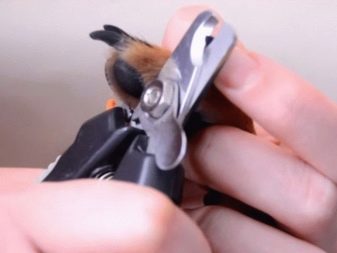
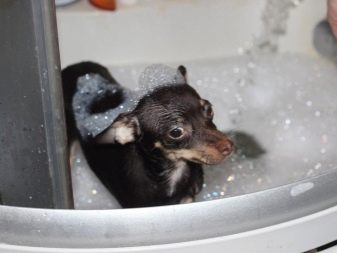
Pets should also regularly inspect their teeth. Animals can be walked at a maximum temperature of -6–7 degrees, clothes should be used at lower temperatures. As a rule, dogs from both breeds are slightly susceptible to diseases, but the main vaccinations are shown to them necessarily, as well as parasite preparations. In summer, flea and tick collars are desirable.
In order for the animal to tolerate nail clipping and bathing, it is advisable to accustom it to such procedures from early childhood.
It is recommended to feed the animals with ready-made balanced feeds, preferably premium or super-premium, and you can also consider canvas for small breeds, but they are the most expensive. For natural feeding, animals should be given low-fat meats, cereals, vegetables and fruits, so that the diet is as balanced as possible.
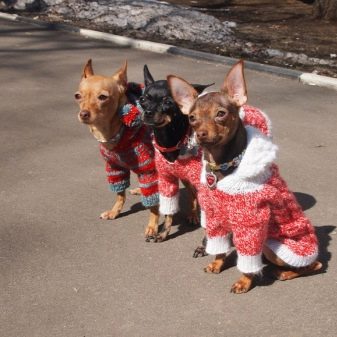
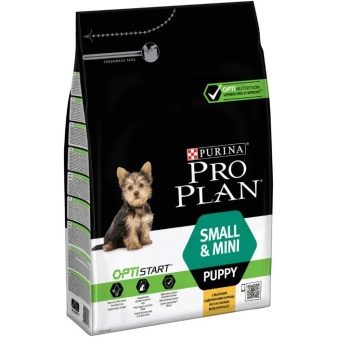
To summarize, it should be noted that to distinguish dogs from two breeds is not so difficult, the main thing is to consider some of their main features. As a pet for an apartment, of course, it is best to choose a toy terrier, because Pinchers need not only a lot of space to spend their energy, but also constant training. Besides, toy terriers are more “domestic” and affectionate favorites, while pinschers are famous for their not always obedient character.
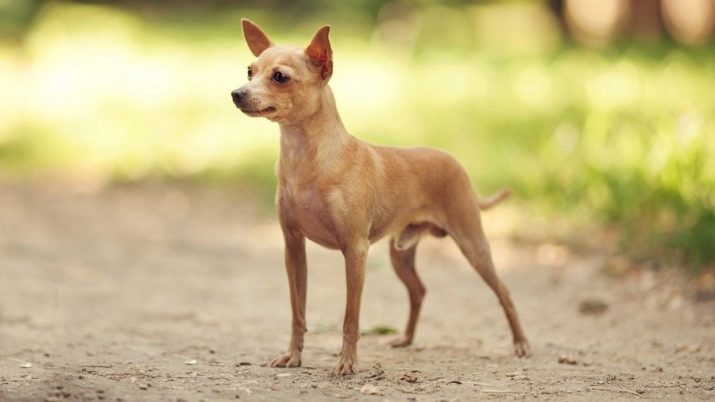
See below for more details.
